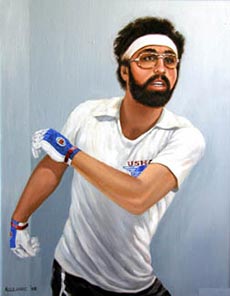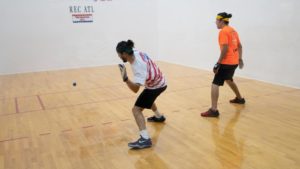 The Coaching Center w/ David Fink: The 2-Wall V Pass: Part Two
The Coaching Center w/ David Fink: The 2-Wall V Pass: Part Two
WPH Press
Coaching Center’s 2-Wall V Pass Part One HERE
The WPH Coaching Center has discussed Coaching, How to See a “Fast Ball,” The Six Walls, The Most Important Shot, The Diet, What Separates Paul Brady, The 3-Wall Power Serve, Doubles Strategies, the Fist to the Ceiling, the Sidearm Kill, the Paddle Kill, and much more. The WPH Coaching Center will continue to examine the various strategies and shots that will make you a better handball player, as this week’s WPH Coaching Center will analyze the 2-Wall V Pass.
The handball highlight reels are littered with flat rollouts, ace serves, and diving retrieves, while the 2-Wall V pass receives far less notoriety. The 2-Wall V Pass is a devastating shot that can be used to gain court positioning, as a rally-ender, or as a defensive shot. Unlike a kill shot that needs to hit the front wall six inches or lower to be successful, or an ace serve that must cross the short line by no more than six inches, the 2-Wall V Pass has a much larger margin. The 2-Wall V Pass can serve as a rally-ender by hitting anywhere from six-to-twelve feet high on the front wall and six inches-to-five feet high on the front wall. Fred Lewis once said that he won a national title without a kill shot – he didn’t need it, he had the 2-Wall V Pass! The 2-Wall V Pass is a steady shot that can be executed on the days you cannot locate your two-inch high kills. Not only can the 2-Wall V Pass serve as a rally-ender, but it can also serve as a demoralizer and a “wind-sucker,” as your opponent will be gasping for air as he runs to the backcourt chasing the angled rocket.
In Part One of The 2-Wall V Pass, the Coaching Center’s esteemed panel of Fred Lewis, Danos Cordova, and Naty Alvarado, Jr. discussed How to hit the 2-Wall V Pass, breaking down the setup, contact point, aim, trajectory, pace, type of spin, weight transfer, and more.
In Part Two of The 2-Wall V Pass, our esteemed panel of experts will discuss when to hit the 2-Wall V Pass, and just as importantly, what to expect after hitting the shot.
When to hit the 2-Wall V Pass
Now that we’ve learned How to hit the 2-Wall V Pass, we need to know When to hit the pass. Our esteemed panel of experts returns to breakdown the court positioning, strategy, the angle, and more.
Fred Lewis
In terms of positioning, the hitter is behind the opponent and at an angle. The easiest to understand example is when the opponent is at the short line in the middle of the court. The hitter, assuming a right handed player, is on the right side of the court behind the opponent.
A couple different situations for when a pass shot is the smart play. Maybe your opponent is playing very far forward. A good indicator for that is if he/she is digging up some of your good kill shots. If you hit a couple pass shots, they’ll be forced to take a couple steps back to cover the back court and your good kill shots should earn points. Another good situation is when you are having a hard time getting your opponent out of the middle of the court. An effective 2 wall pass shot will force them to leave the middle of the court
When hitting this shot, you should be somewhere in front of the restraining line and your opponent should be somewhere in front of you
Naty Alvarado, Jr.
The exact time when to use a two wall V pass is dependent on the position of your opponent.
Hit the 2-Wall V Pass when trying to regain position against your opponent. There’s a match on video that I used to watch between my father and Poncho Monreal. They were both striking elegant V pass rockets at one another to regain position against one another. If you were to watch that match using a symphony orchestra playing Mozart you would gain a respectful timing and placement of each shot.
What to do after hitting a successful 2-Wall V Pass
Now that you’ve crushed a perfect 2-Wall V Pass, what should you do? Fist pump? Wave to the crowd? Nope…be ready for a kill shot opportunity!
Fred Lewis
In the event the opponent manages to retrieve the shot, in all likelihood it will come back as a set up for a kill. In any event the opponent has given up front court position which is one of the objectives of playing winning handball. It also takes more energy to retrieve a pass shot than a kill shot. You can win a match just as easily by submission as you can by a knockout.
Danos Cordova
Be aggressive after a strong 2-wall pass. It’s hard to fly those returns because they’re usually a weak low return, but you’ll have a lot of time to step back and attack the ball
Naty Alvarado, Jr.
Maybe the sexiest shot in handball. In some cases it is more demoralizing than kill shot. The shot can cause such an empty feeling in your opponent for either miss playing, overstepping, or not understanding his court position versus mine.
I always think of John Kendler warming up against my father in Atlanta in 1990′ striking controlled V passes during his Pro Singles final warm-up. I also have fond memories of playing doubles with David and watching him destroy our opponent’s offensive position with a crisp perfectly angled the past to the deep left corner.
Thank you to our experts for helping us to become better 2-Wall passers!
David Fink
WPH Senior Writer










